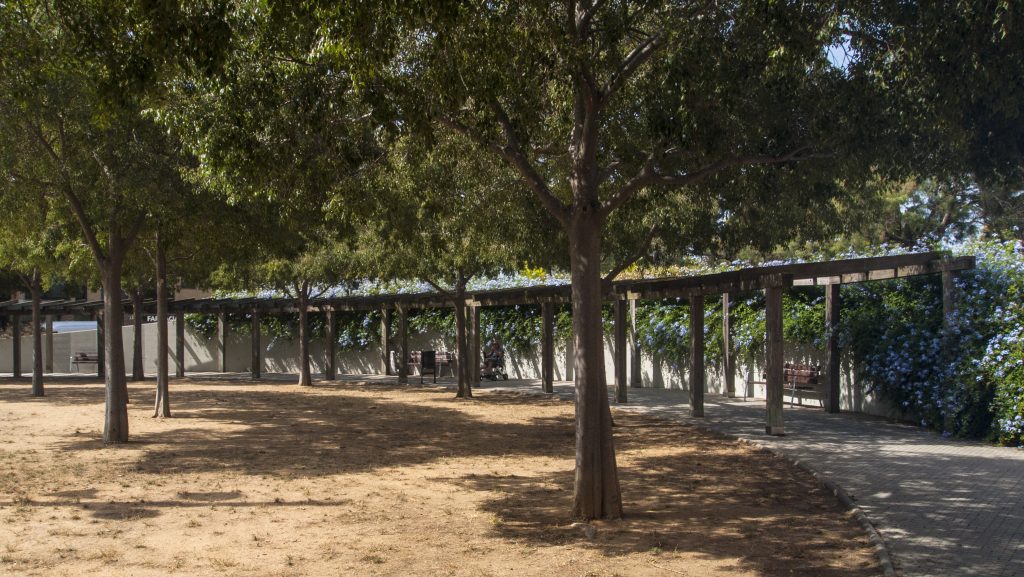ENVIRONMENT AND CLIMATE CHANGE
Malgrat de Mar’s bioclimatic network: building heat resilience and boosting urban biodiversity

Malgrat de Mar’s heat adaptation strategy focuses on creating a network of bioclimatic shelters to enhance heat resilience and urban biodiversity. The city implements both outdoor shelters with high green surface coverage and indoor shelters that maintain comfortable temperatures.
Through a vulnerability analysis considering environmental, spatial, and socio-economic factors, the city identifies strategic locations for these shelters, aiming to protect vulnerable populations during heat waves and improve overall climate resilience.
Challenges addressed
• Urban Heat Island effect: The network of bioclimatic shelters helps reduce localized heat and provides cooler spaces for urban residents.
• Protection of vulnerable populations: heatwaves disproportionately impact at-risk groups, such as the elderly, children, and individuals with health conditions.
• Urban biodiversity loss: due to the urban development that reduces green spaces, negatively affecting biodiversity.
Main objectives
• Adapt the city to climate change, through the implementation of spaces that mitigate the effects of heat waves and torrential rains.
• Improve the quality of urban green spaces, increasing biodiversity and ecological connectivity within the municipality.
• Reduce the urban heat island effect, through designs that regulate temperature and provide thermal comfort to citizens.
• Promote an ecosystem vision, considering both humans and other organisms in the planning of bioclimatic shelters.
External resources
Facts
Project type Climate shelter’s network project
Partners Paisaje Transversal, Diputació de Barcelona
Beneficiaries Malgrat de Mar municipality
Dates 2024 – Ongoing
Website Bioclimatic network project (in Spanish)
Project description
This project covers the idea of shelter in a scenario where not only the impact of temperatures on humans is resolved but also addresses this ecosystemic vision.
One of the first cases of its application and formulation has been established in Malgrat de Mar, a city that, in recent years, has made a strong effort through innovative interventions for adaptation to climate change, with naturalization and urban green projects, rain gardens or interventions to promote and care for the biodiversity of its territory, among others. There, Paisaje Transversal, and with the help of the Barcelona Provincial Council, we have had the opportunity to establish a study for the future creation of a network of bioclimatic shelters for the municipality.
Furthermore, it should be noted that the study does not stop at these but defines design criteria to improve the quality of urban green spaces and thermal regulation to combat the heat island effect, improve ecological connectivity and provide ecosystem value to the urban fabric. This work also serves to generate a conceptual and strategic framework to organize and prioritize interventions in the urban environment of the municipality.
Specifically, the project covers the following steps or objectives to follow to implement the shelter network:
1. Define a conceptual framework
2. Characterize bioclimatic shelters
3. Analyse urban vulnerabilities
4. Identify existing and potential bioclimatic shelters
5. Analyse accessibility to bioclimatic shelters
6. Establish a strategic vision at an environmental level for the municipality
Impact and results
• Reducing heat stress in urban areas: creating spaces that mitigate extreme heat, especially in vulnerable areas, and improving thermal comfort for the population, prioritizing the most sensitive groups (elderly people, children and groups with fewer resources).
• Increasing biodiversity and ecological connectivity: Promoting habitats for local flora and fauna and creating ecological corridors that connect existing natural spaces with urban areas, promoting the presence of native species.
• Adaptation to climate change: increasing urban resilience to high temperatures and extreme events, aligning with global environmental objectives and improving green infrastructure, such as the implementation of low-water consumption vegetation and draining pavements.
• Social cohesion and urban equity: creating accessible, inclusive and safe spaces for different social groups and reducing urban inequalities by prioritizing interventions in areas with greater socio-economic, environmental and spatial vulnerabilities.
Publications & main documents
RELATED CONTENT
Sorry, no posts matched your criteria.


